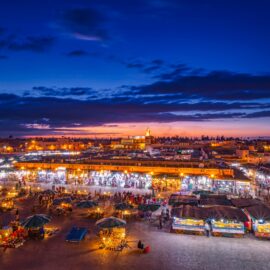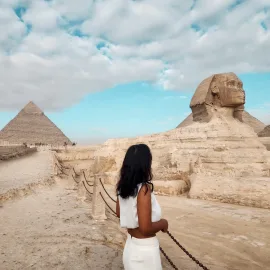As part of my quest to visit all 195 UN-recognized countries, I’ve explored 102 incredible destinations. Now, I’m diving into my 103rd country—Tunisia—after a memorable 5 days in Egypt and 5 days in Jordan. This guide to backpacking in Tunisia reflects my solo travel experience, offering tips and insights to help you explore this diverse and exciting destination.
Tunisia is a North African gem, where ancient ruins, lively Medinas, and Mediterranean beauty blend seamlessly. The capital city, Tunis, perfectly combines rich history with modern life, making it an ideal starting point for any adventure. From wandering through the ancient Medina of Tunis to exploring the historic ruins of Carthage and vibrant coastal towns, this 5-day itinerary covers the must-see spots of Tunisia.
I am on the mission to travel all the 195 countries in the world (not in a race, more like in a slow and steady fashion) and recently completed 108 countries. It was a big milestone because I work hard, save for these trips and share what I know here on the blog for free so fellow travellers like you can benefit from it. Pls feel free to return the favour by ordering my new book on Amazon – A solo female traveler’s story: from Kathmandu to finding peace in 100+ countries
After the hustle and bustle of Cairo, I felt an immediate sense of peace upon arriving in Tunisia—a welcoming and serene atmosphere that sets this destination apart. Tunisia offers solo female travelers the perfect mix of history, culture, and natural beauty. Since I’ve already experienced the vast Sahara Desert in Morocco, I chose to focus on other fascinating highlights of Tunisia, showcasing the country’s diverse and lesser-known treasures.
Know before you go to Tunisia

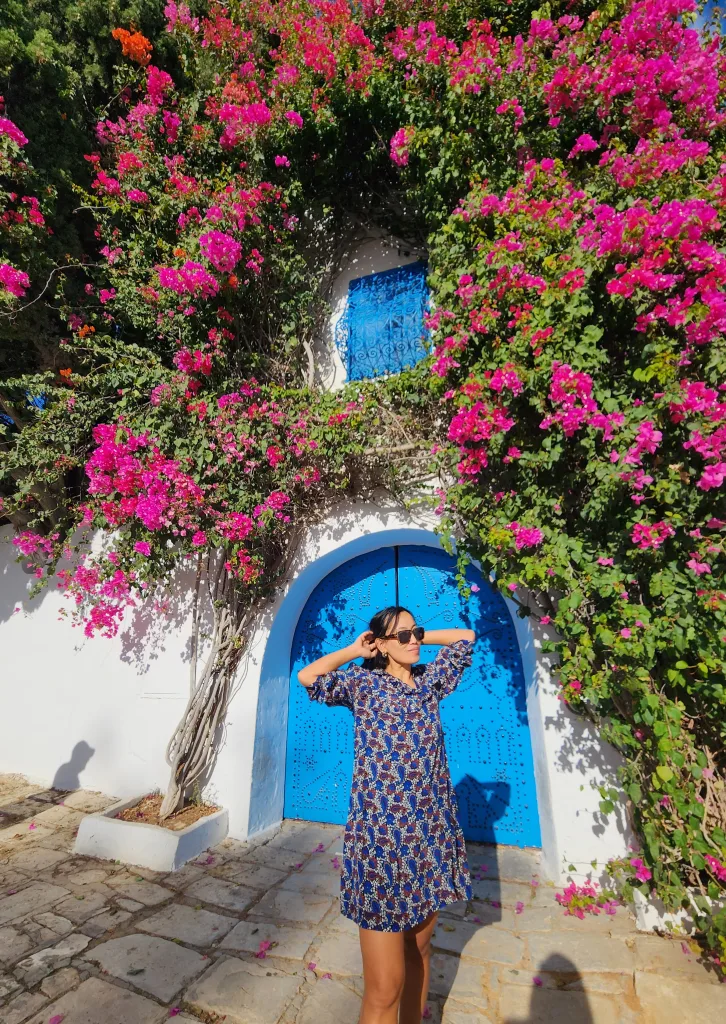
Why Visit Tunisia: Tunisia is a gateway to ancient civilisations, stunning desert landscapes, Mediterranean beaches, and vibrant cities.
Best Time to Visit: Spring (March to May) and autumn (September to November) offer pleasant weather, perfect for sightseeing and desert excursions.
Getting Around:
- Shared taxis ( louage) are budget-friendly and widely available.
- For more flexibility, consider renting a car.
- Uber and Careem are available in larger cities, offering convenient travel options.
Language spoken: The primary language spoken is Arabic, specifically Modern Standard Arabic for formal communication and Tunisian Arabic (also known as Derja) for everyday conversation. French is widely spoken due to Tunisia’s historical ties with France, and it is often used in business, education, and government. Many younger Tunisians, especially in urban areas, also speak English, particularly in tourist areas, hotels, and restaurants.
Currency:
- Tunisian Dinar (TND): Currency exchange on arrival.
- Credit cards are accepted in major cities, but cash is recommended for rural areas.
Insider Tip:
Make sure to keep the receipt when you exchange USD or other currencies to TND. You’ll need it if you want to change any remaining TND back to USD or Euros at the end of your trip. Without the receipt, they won’t exchange it for you. Once you pass security, no shops there will accept TND so use it before that or just don’t throw away the receipt. Luckily, I met a Tunisian flying to Malta and he exchanged my TND for Euros as he most likey will be back home at some point.
Make sure to withdraw close to what you’ll actually spend, as you can’t exchange TND back to USD or Euros. Always plan ahead and be aware of the currency exchange rules when traveling.
Also, there is no online check-in available for some flights, and no clear signs of the Airline check in desk at the departure either. It took good 20 mins to find Tunis airline check in desk as it was hidden at the back on the ground floor. Be sure to arrive at the airport with enough time to handle check-in in person especially if it’s international flight.
Ultimate backpacking in Tunisia: 5 day itinerary
Day 1: Exploring Tunis – A perfect introduction to Tunisia




After landing in the mid-morning, I hopped into a taxi and headed straight to the heart of Tunis. I checked into my accommodation, dropped off my bag, and set off to explore the city.
I was hungry so my first stop on my backpacking in Tunisia journey was Dar Slah, a local’s favourite restaurant offering authentic Tunisian cuisine. The 2 course meal began with a traditional Tunisian soup, served alongside a selection of assorted appetizers, offering a delightful taste of the local ingredients and spices. For the main course, I enjoyed couscous with fish, a classic and satisfying dish that truly captured the essence of Tunisian cuisine. Bread was extra, adding to the rustic charm of the meal. 38 TND and with an additional 2 cups of tea bringing the total to 43 TND—a perfect introduction to the local flavors.
From there, I wandered through the bustling souqs—thousands of shops lining narrow streets, selling everything from traditional textiles to spices. The vibrant energy was palpable as I walked deeper into the maze of shops. Food section was very welcoming, some even offering complementary dessert to try. Recommend the hot dough type biscuits!
Next, I visited the Zeitouna Mosque, which has stood for over 1,500 years. Its grandeur and tranquil atmosphere made it one of the most impressive sites in the city. Not far from the mosque, I explored the Old City Gate, a historical landmark marking the entrance to the ancient heart of Tunis.
Continuing around and through the souqs, I strolled past City Hall and made my way to the Medina, where every corner revealed something new and exciting. The sights and sounds were a sensory overload, and each turn seemed to offer another hidden gem. I then arrived at Kasbah Square, a lively area full of history. While standing near the square, I was unexpectedly treated to a flag-changing ceremony. An army van pulled up a little distance from the flag, and the soldiers began speaking in a language I didn’t understand before driving off. It was a unique, unexpected experience that added a local touch to my day.
After the ceremony, I found my way to Cafe Panorama for the perfect sunset view, sipping coffee as I took in the breathtaking sights of the city along with Islam prayers at the background. It’s one of the highlights of my Tunisia itinerary. The peaceful atmosphere made for a relaxing end to my day. I then enjoyed a delicious dinner at a nearby restaurant before heading back to my hotel to rest up for the next day’s adventures.
It was a full and exciting first day in Tunis—an enriching mix of history, culture, and local experiences that truly set the tone for my backpacking in Tunisia journey!
For accommodation, I recommend using booking.com and sorting with price, then consider the ones with highest reviews plus within 1km of centre. Below on FAQ section I researched and named the best ones with this filter (at the time of writing)
For tours, I recommend using get your guide and walking tours available in most places.
Day 2: Coastal escapes and culinary delights in Tunis
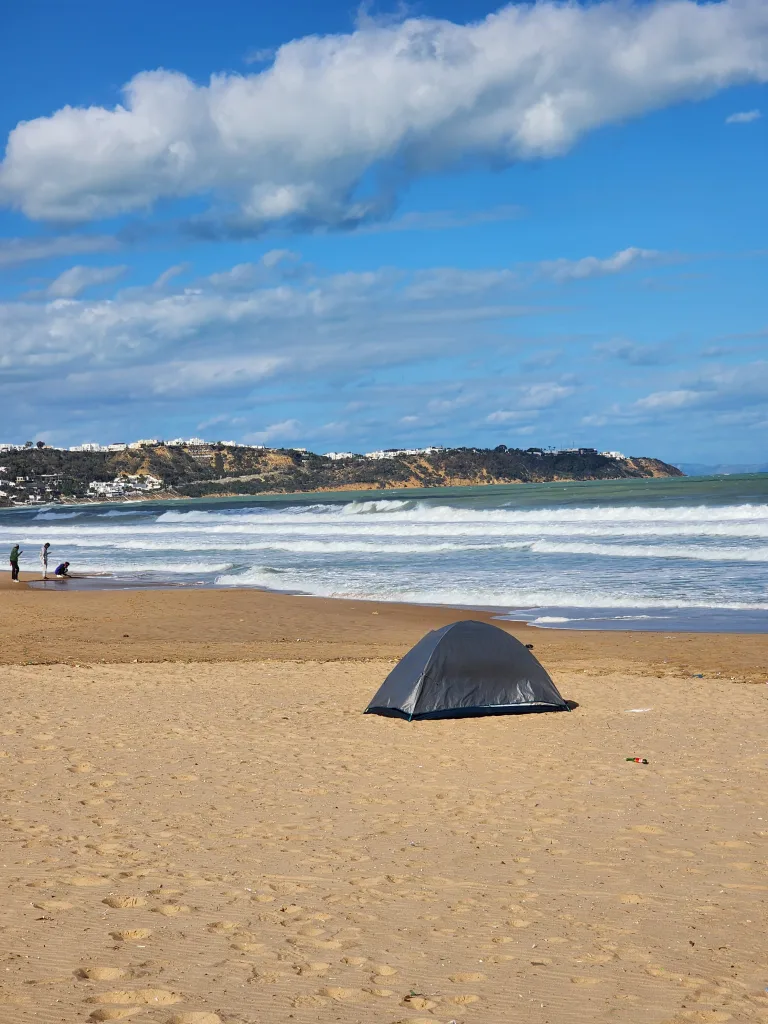
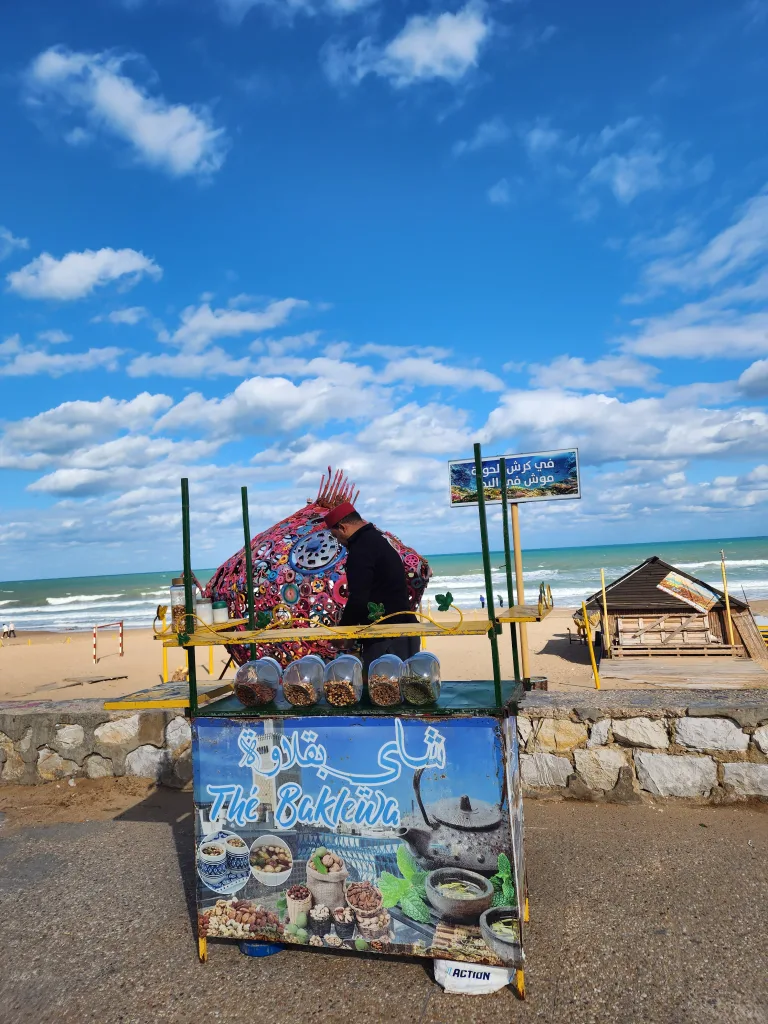
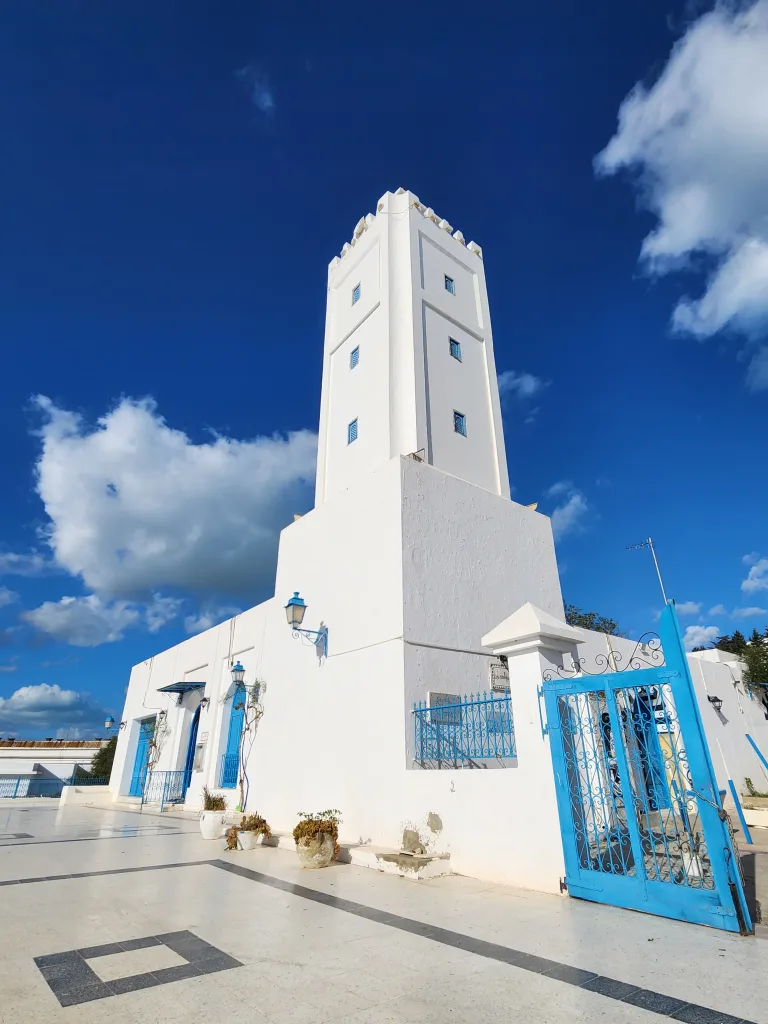


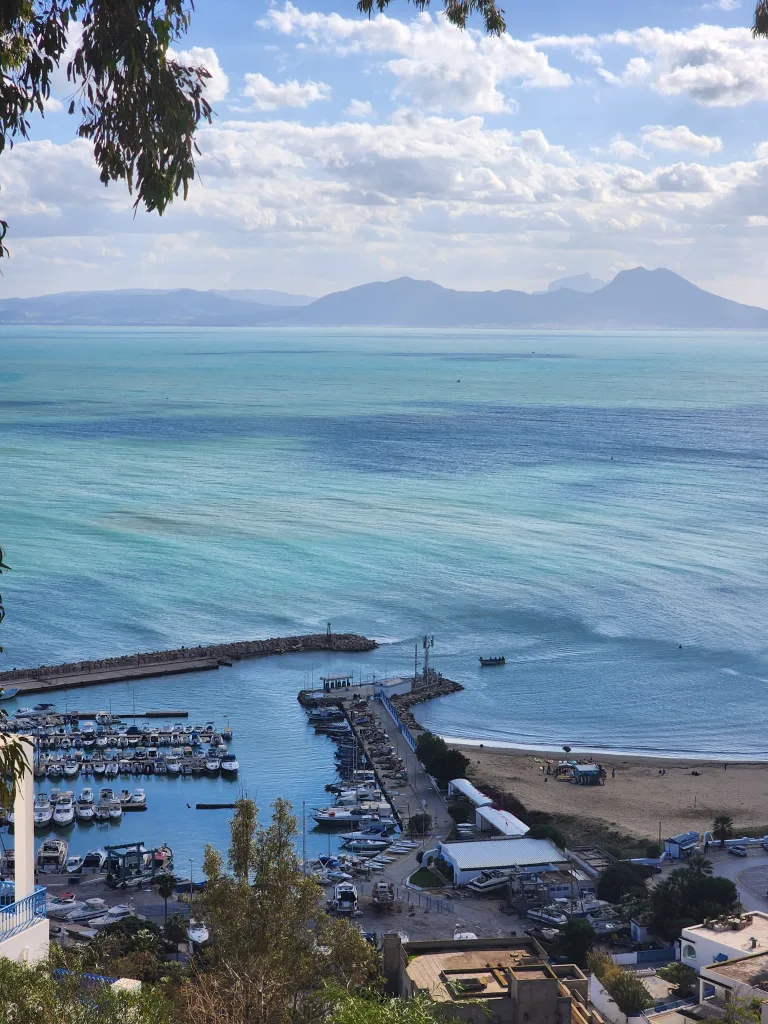

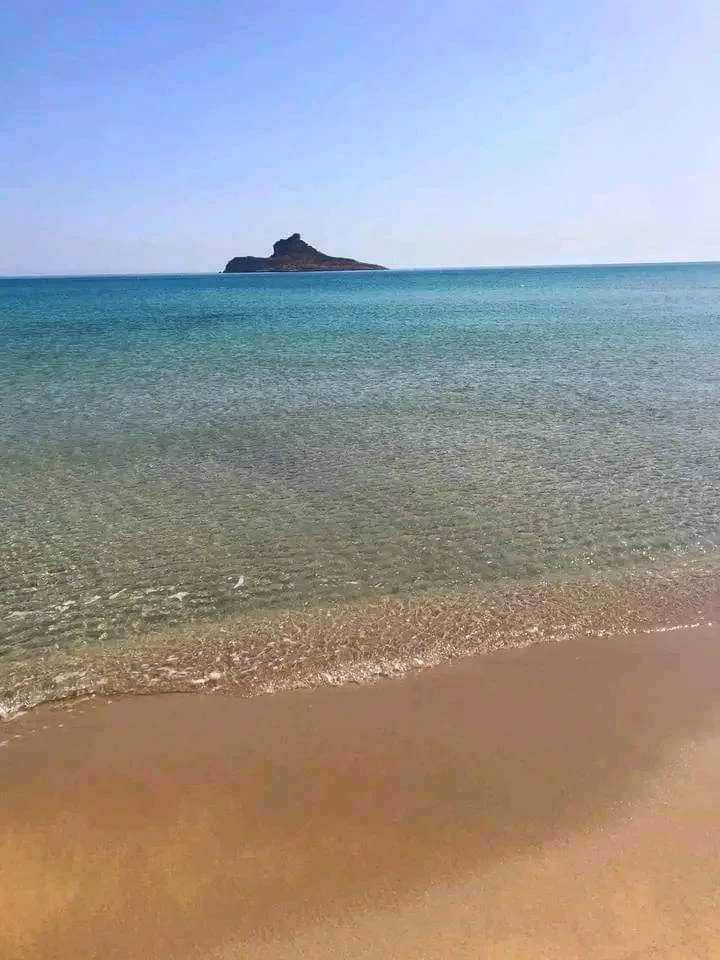
I started my second day backpacking Tunisia bright and early, with my alarm going off at 7:00 AM. After a slow start, I was up by 7:30 AM and enjoyed a traditional Tunisian breakfast to fuel my day of exploration. By 9:30 AM, I set out for a coastal escape, heading towards La Marsa Beach.
The journey took longer than expected due to marathon road closures, but by noon, I finally arrived at La Marsa. I took the train from town to La Marsa. The beach was worth the wait—a peaceful stretch of golden sand meeting the sparkling Mediterranean Sea. I took my time soaking in the coastal views and enjoying the laid-back vibe, a perfect contrast to the bustling Medina.
This could easily be a day trip but I wanted to see more so after relaxing by the sea, I decided to continue my coastal journey with a scenic 35-minute walk to the charming cliffside village of Sidi Bou Said. This iconic town, with its whitewashed buildings and blue shutters, felt like stepping into a postcard. I explored the narrow cobblestone streets, stopping by Ennejma Ezzahra, a stunning palace-turned-museum that showcases traditional Tunisian architecture and offers breathtaking views of the coastline. Backpacking in tunisia wouldn’t be complete without a visit to Sidi Bou Said, don’t miss the snack shops!
From there, I wandered down to the nearby Lake of Tunis, taking in the peaceful scenery before making my way back to the Medina. It was time again to dive into Tunisia’s rich food scene. I treated myself to a feast of local dishes—starting with a hearty tajine, followed by the classic lablabi (a flavourful chickpea soup), and the crispy, savory brik. I couldn’t resist sampling even more street food, including a fricassé (a fried sandwich), ojja (spicy tomato and egg dish), and some comforting riz (rice).
As the day began to wind down, I sought out the perfect sunset spot (terrace of my accommodation – where to stay tips below). Watching the sun dip below the horizon, painting the sky in hues of orange and pink, was the perfect way to end an eventful day.
Day 3: Ancient wonders and coastal flavours
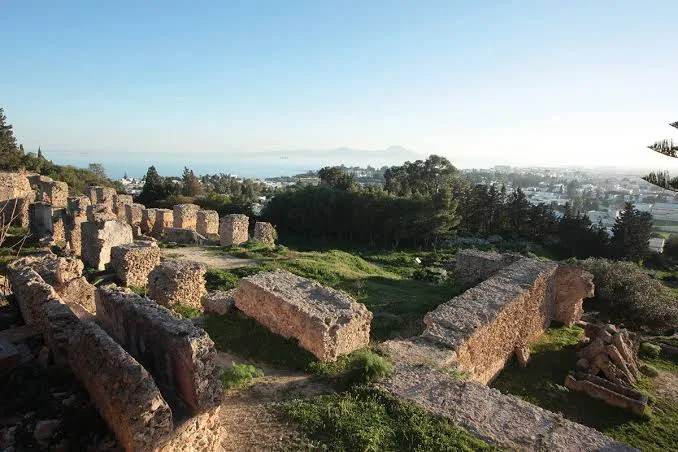

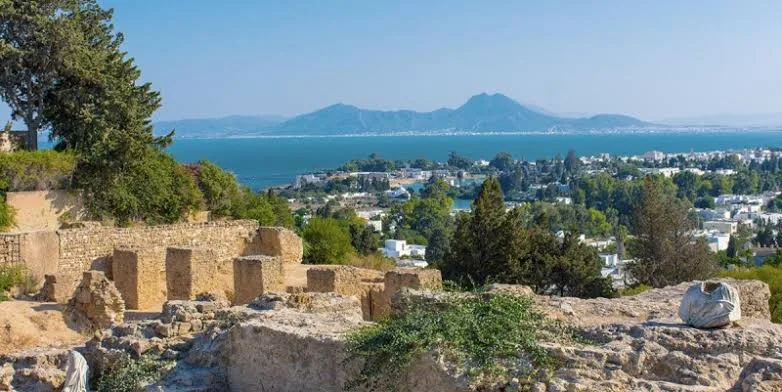
Day 3 on this Tunisia travel guide is dedicated to uncovering Tunisia’s rich history and savouring its coastal charm. The day begins with a journey to the legendary Carthage Ruins, one of the most iconic historical roman ruins in the country. Once a thriving Phoenician city and later a significant part of the Roman Empire, Carthage now offers a fascinating glimpse into ancient civilisations. The sprawling ruins, including the impressive Antonine Baths, ancient villas, and the sacred Tophet, stand as powerful reminders of Tunisia’s layered past. With the Mediterranean Sea as a backdrop, the site beautifully merges history with nature.
In case you started a day bit late today as the day winds down, Byrsa Hill in Carthage provides stunning sunset views over the ancient ruins and the Mediterranean Sea. The golden light casts a magical glow over the historical landscape, offering a reflective moment to appreciate Tunisia’s beauty.
Alternatively, after exploring Carthage, it’s time to unwind in the nearby coastal suburb of La Marsa. Lunch at the popular Chez Achour offers the perfect taste of Tunisia’s seafood-rich cuisine. A flavorful seafood platter, freshly grilled and expertly seasoned, captures the essence of Mediterranean flavors in a relaxed seaside setting.
The afternoon continues with a visit to the Medina of Tunis, where Dar Belhadj awaits. This beautifully restored traditional house, now serving as a restaurant and cultural space, showcases Tunisia’s exquisite architecture. Intricate tile work, arched doorways, and peaceful courtyards create a serene atmosphere, offering a quiet moment to appreciate the country’s rich heritage.
To close out the day, a leisurely walk through the bustling Medina reveals vibrant souks filled with artisan goods, traditional crafts, and the lively rhythm of local life.
For accommodation, I recommend using booking.com and sorting with price, then consider the ones with highest reviews plus within 1km of centre. Below on FAQs section, I researched and named the best ones with this filter (at the time of writing)
For tours, I recommend using get your guide and walking tours available in most places.








Day 4: Coastal escapes to Hammamet and Nabeul
I know its a backpacking in Tunisia but no harm in checking out some pricey areas. Day 4 offers the perfect blend of relaxation and cultural discovery along Tunisia’s stunning coastline. The morning begins with a trip to the charming seaside town of Hammamet, renowned for its beautiful beaches and laid-back atmosphere. Arriving early allows for peaceful exploration before the crowds settle in.
The first stop is the Hammamet Medina, a walled old town filled with narrow, winding streets and whitewashed buildings. Vibrant blue doors and intricate tilework create a postcard-worthy setting. Wandering through the souks reveals shops brimming with handmade ceramics, colourful textiles, and traditional crafts. From the Medina, panoramic views of the Mediterranean Sea stretch endlessly, where waves gently lap against the fortified walls.
For lunch, a cozy local restaurant serves up classic Tunisian flavors. Dishes like savory tajine, crispy brik, and freshly caught seafood highlight Hammamet’s culinary charm. The seaside backdrop adds to the experience, blending good food with a calming atmosphere.
In the afternoon, it’s time to head to Nabeul, a nearby town famous for its pottery and bustling markets. The Nabeul Market buzzes with life—stalls overflow with handcrafted pottery, woven baskets, fragrant spices, and vibrant Tunisian goods. Local artisans proudly display their work, making it a perfect place to pick up unique souvenirs.
As the day winds down, a peaceful coastal walk offers a moment to soak in the views and reflect on the day’s discoveries.
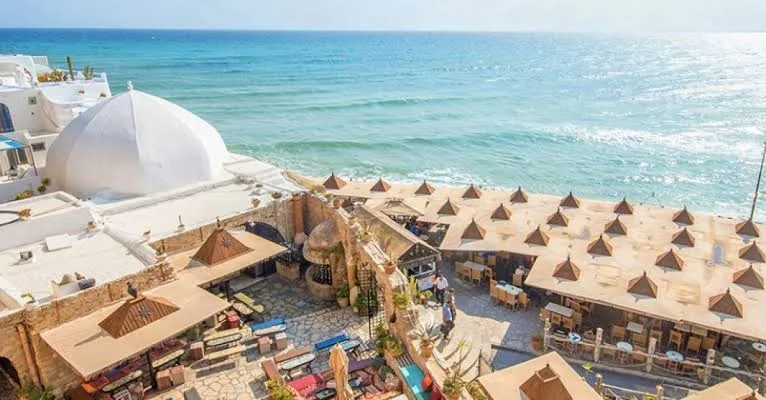
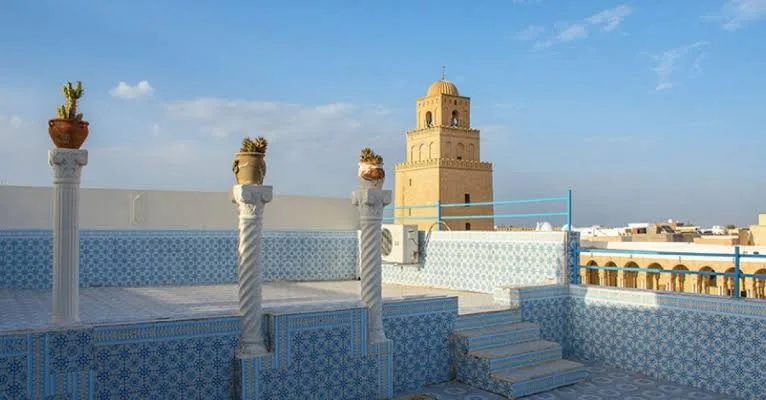
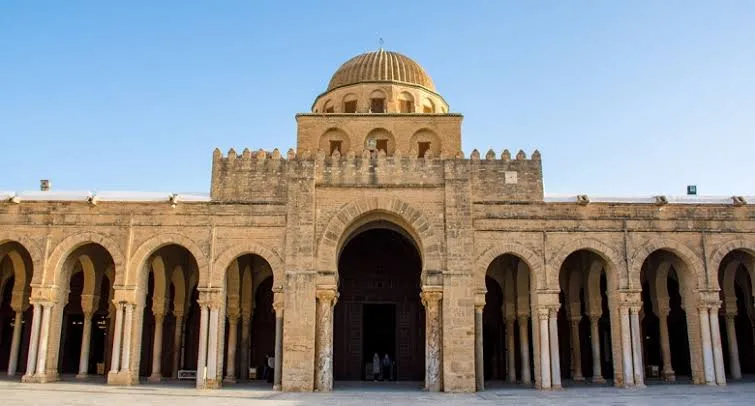
Day 5: Sacred history in Kairouan and a peaceful farewell in Tunis
Day 5 offers the perfect balance of cultural immersion and relaxation to conclude a memorable Tunisia adventure. The morning begins with a trip to Kairouan, Tunisia’s spiritual heart and a UNESCO World Heritage Site. Known as one of the holiest cities in Islam, Kairouan is filled with centuries-old history and stunning architecture.
The first stop is the iconic Great Mosque of Kairouan, one of the oldest and most significant Islamic monuments in North Africa. Its massive stone walls, towering minaret, and peaceful courtyard create a serene atmosphere steeped in history. Wandering through the Medina of Kairouan, quiet alleyways reveal artisan workshops and local markets offering traditional goods. Nearby, the ancient Aghlabid Basins showcase impressive medieval engineering, once used to store water for the city. A visit to Kairouan isn’t complete without tasting the city’s famous sweet pastry, Makroud, made with dates and semolina—a perfect midday treat.
Alternate location: Ksar Ouled soltane
In the afternoon, the journey returns to Tunis for some well-deserved relaxation. A peaceful walk along the Lake of Tunis offers a quiet escape from the city’s bustle. The lakeside cafés are ideal for sipping traditional mint tea or coffee while soaking in the views.
For the final evening of backpacking in Tunisia, a farewell dinner at a rooftop restaurant in the Medina of Tunis or along the La Goulette waterfront is the perfect way to end the trip. The combination of flavourful Tunisian dishes and a relaxed atmosphere creates a memorable closing to this 5 days Tunisia itineray.
FAQs for backpacking in Tunisia
1. Is it safe to travel in Tunisia now?
At the time of writing traveling to Tunisia is possible, but it’s essential to exercise caution due to certain safety concerns.
Key safety considerations:
- Terrorism risk: There is a heightened risk of terrorism throughout Tunisia. Travellers are advised to remain vigilant, especially in crowded places and tourist sites.
- Restricted areas: Certain regions are considered high-risk and should be avoided:
- Within 16 km of the Algerian border, except for the cities of Tabarka and Ain Draham.
- Within 16 km of the border with Libya.
- The Mount Chaambi National Park, Mount Salloum, Mount Sammamma, and Mount Mghila in Kasserine governorate.
- The Mount Orbata area in the Gafsa governorate.
- The desert south of Remada due to the military zone.
Recommendations for travellers:
- Stay informed: Regularly consult official travel advisories from your home country’s government.
- Exercise vigilance: Be alert in public places, especially in crowded areas and tourist attractions.
- Avoid restricted areas: Steer clear of regions identified as high-risk.
- Local guidance: Follow instructions from local authorities and tour operators.
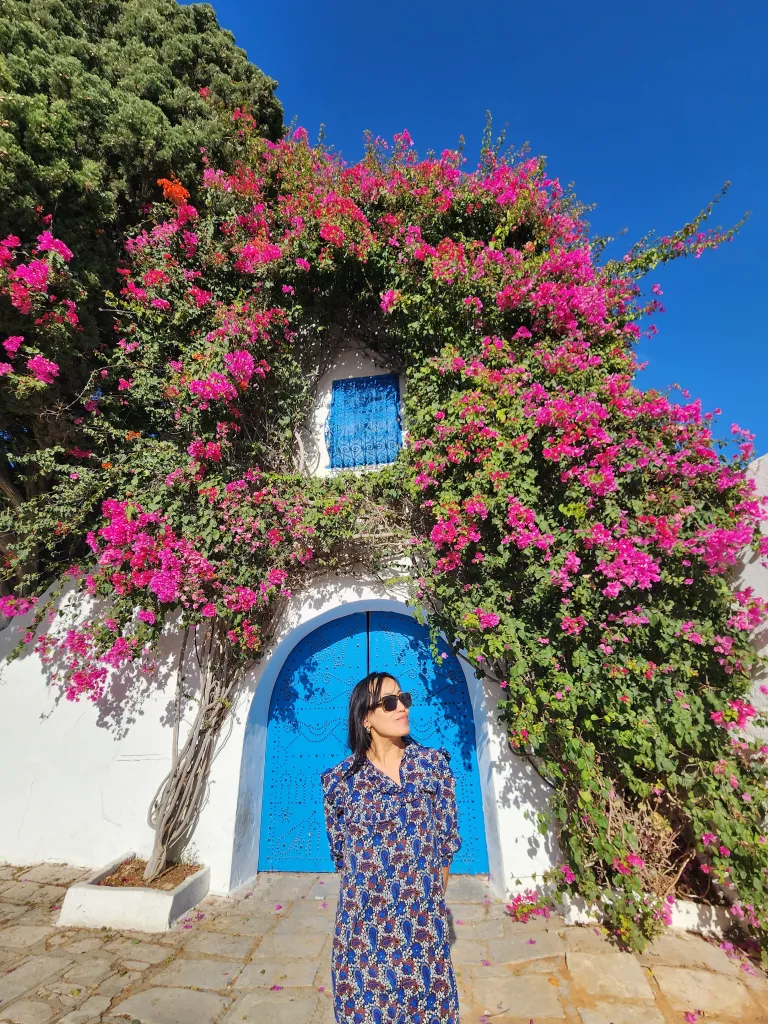



2. Do tourists have to wear hijab in Tunisia?
No, tourists do not have to wear a hijab in Tunisia. The country is relatively liberal compared to some other parts of the region, and there is no legal requirement for foreign visitors to wear the hijab or cover their hair.
However, it is recommended to dress modestly, especially when visiting religious sites such as mosques, in order to show respect for local customs and culture. Women are generally expected to cover their shoulders and wear longer, more conservative clothing, like long skirts or pants, when entering these sites.
In everyday settings, such as at the beach or in tourist areas, tourists can wear typical Western-style clothing like swimsuits, shorts, and t-shirts without issue. Tunisia’s larger cities, such as Tunis, are more cosmopolitan, while rural areas might be more conservative, so adjusting clothing according to the setting can be helpful.
3. Can you drink tap water in Tunisia?
In Tunisia, it is generally not recommended to drink tap water, especially for tourists. While tap water in urban areas such as Tunis may meet basic safety standards, it can still have a different mineral content and taste that might upset the stomach of travellers who are not accustomed to it.
Key points on water safety in Tunisia:
- Tap water:
- Tap water in larger cities is usually chlorinated, so it’s not inherently unsafe, but it may cause stomach issues for those not used to it, due to differences in the mineral composition.
- In rural areas or smaller towns, the tap water may not be treated as rigorously, and it’s best to avoid drinking it entirely.
- Bottled water:
- It’s highly recommended to drink bottled water, which is widely available and inexpensive in most places.
- Bottled water is the safest option, and it can be found in supermarkets, cafes, restaurants, and street vendors.
- Boiling water:
- If bottled water is not available, boiling water is another safe option, especially for making tea or coffee.
- Avoid Ice:
- If you’re in a place where the water quality is questionable, it’s also a good idea to avoid ice in drinks, as it may be made from tap water.
4. Is it cheap in Tunisia for tourists?
Yes, Tunisia is considered an affordable destination for tourists compared to many other countries in Europe or the Middle East. Costs can vary depending on the type of experience you’re looking for, but generally, Tunisia offers great value for money. Here’s an overview of costs you can expect:
Accommodation:
- Budget accommodation, such as guesthouses and hostels, can be as low as 20–30 TND ($6–$10 USD) per night.
- Mid-range hotels typically cost between 70–150 TND ($23–$50 USD) per night.
- High-end hotels and resorts can be more expensive, with prices starting around 200 TND ($67 USD) and going up, especially in tourist-heavy areas like Hammamet or Djerba.
Food and drink:
- Street food and casual eateries are inexpensive. A simple meal, such as a sandwich or a plate of couscous, might cost around 5–10 TND ($2–$3 USD).
- A traditional Tunisian restaurant meal will typically cost between 15–30 TND ($5–$10 USD) for a full course, with dishes like brik, tajine, or grilled fish.
- Drinks such as coffee or tea usually cost between 2–5 TND ($0.70–$1.70 USD).
- Imported drinks (like soda or alcohol) can be more expensive, particularly in tourist areas.
Transportation:
- Public transportation in Tunisia, such as buses or the metro in Tunis, is quite affordable. A bus or metro ride can cost around 1–2 TND ($0.30–$0.70 USD).
- Taxis are relatively cheap, with fares starting at around 5 TND ($1.70 USD) for short rides, and prices increase depending on distance.
- Renting a car can cost between 80–150 TND ($27–$50 USD) per day.
Attractions and tours:
- Entrance fees to historical sites and museums are generally low. For example, the Carthage ruins or Medina in Tunis can have entrance fees around 5–10 TND ($1.70–$3.30 USD).
- Guided tours, especially those to more remote or popular tourist spots, may cost 50–150 TND ($17–$50 USD) per day, depending on the length and type of tour.
Shopping:
- Souvenirs such as pottery, textiles, or spices are generally affordable, but prices will vary based on quality and bargaining skills.
- Bargaining is common in markets (souks), so be prepared to negotiate for the best prices.
5. Can you wear shorts in Tunisia?
Yes, you can wear shorts in Tunisia, but it’s important to consider the context and the location. Here’s a general guideline:
Tourist areas and beaches:
- In beach resorts and tourist areas like Hammamet, Sousse, or Djerba, wearing shorts is perfectly fine, especially in more casual settings. It’s common to see tourists wearing shorts, t-shirts, and swimsuits.
- Swimming pools and beaches are also places where wearing shorts or swimwear is expected.
Cities and urban areas:
- In larger cities like Tunis or Sfax, wearing shorts is acceptable, particularly in tourist areas. However, it’s best to be a bit more mindful of your surroundings.
- When walking around cities, modesty is appreciated, especially in areas where the local population is more conservative. Women might want to consider wearing knee-length shorts rather than very short ones to show respect for local customs.
Religious and historical sites:
- When visiting mosques, medinas, or other religious sites, it’s recommended to dress modestly. Women and men should ideally cover their knees, and women may also want to cover their shoulders. A simple scarf or shawl can be useful to cover up when entering a mosque.
Rural areas:
- In more rural or conservative areas, locals tend to dress more modestly, so it’s advisable for both men and women to avoid wearing very short shorts in these areas. Opt for longer, more modest clothing to blend in and show respect for local traditions.
General advice:
- Tunisia is more liberal than some of its neighbouring countries, and wearing shorts is generally accepted, but it’s always best to be respectful and considerate of the local culture, especially in more conservative or rural areas.



6. What is the etiquette in Tunisia?
In Tunisia backpacking, like in many countries, being mindful of local etiquette and customs will enhance your experience and show respect for the local culture. Here are some key points of Tunisian etiquette that tourists should keep in mind:
I. Dress modestly
While Tunisia is more liberal compared to some other North African countries, it is still a conservative society, especially outside of major tourist areas.
- Women should avoid wearing very short skirts, shorts, or revealing tops when outside of beach areas or tourist resorts. It’s recommended to wear knee-length skirts or pants and cover your shoulders when in public spaces or visiting religious sites.
- Men should also avoid wearing sleeveless shirts and very short shorts in public areas, especially in rural and conservative settings.
- Religious Sites: When visiting mosques or other religious places, both men and women should cover their knees, shoulders, and sometimes their heads (for women). You may be asked to remove your shoes when entering mosques.
II. Greetings and respect for elders
- A handshake is a common greeting, but in more conservative settings, men and women may avoid shaking hands. If you’re unsure, you can offer a friendly nod or verbal greeting.
- Address elders with respect, using titles like “Sidi” (for men) and “Siti” (for women) as a sign of respect. Tunisians value respect for age and seniority.
III. Avoid public displays of affection
Public displays of affection, such as kissing or hugging, are generally considered inappropriate in Tunisia, especially in more conservative or rural areas. It’s best to show affection in private or in tourist areas where it’s more accepted.
IV. Table manners
- Dining Etiquette: Meals are often served family-style, and it’s common to share dishes. It’s customary to eat with the right hand, as the left hand is considered unclean in some cultures.
- Invitations to Eat: If you’re invited to someone’s home, it’s polite to bring a small gift, such as sweets or fruit, as a token of appreciation. When invited to dine, it’s respectful to try a bit of everything on the table.
- Finishing Food: It’s common to leave a little food on your plate to show that you’re satisfied. Finishing everything might imply that you were still hungry.
V. Tipping
Tipping is customary in Tunisia and is appreciated for good service. You may tip in restaurants, cafes, taxis, and even for services like hotel porters or guides. While tipping is not mandatory, it is a sign of respect and gratitude.
- Restaurants: A tip of about 10% of the bill is common if service isn’t included.
- Taxis: Rounding up the fare or adding a small tip (around 1–2 TND) is customary.
VI. Bargaining
In markets (souks), bargaining is a common practice. It’s expected that you negotiate prices, and often the starting price will be much higher than the actual price. Be polite but firm when bargaining, and remember that it’s part of the fun!
VII. Respect for religion
- Islam is the dominant religion in Tunisia, and respect for Islamic practices is important. During Ramadan, many local restaurants and cafes may be closed during daylight hours. While tourists are not required to fast, it’s respectful to avoid eating, drinking, or smoking in public during the day in Ramadan.
- During prayer times, you might notice that many shops or businesses close briefly. It’s best to respect these moments of devotion and be mindful of those observing their prayers.
VIII. Photography etiquette
- Ask Permission before photographing people, especially women, in rural or more traditional settings. In some cases, taking pictures of locals without permission can be considered disrespectful.
- Religious Sites: Photography may be prohibited inside mosques or certain sacred areas. Look for signs or ask your guide before taking photos.
IX. Personal space and conversation
- Personal Space: Tunisians may stand closer to each other in public compared to what you might be used to, especially in crowded spaces. However, people are generally friendly and polite, and close proximity is not meant to be intrusive.
- Conversation: Tunisians are known for their hospitality and warmth. It’s common to have long, friendly conversations, especially over a cup of tea or coffee. Politics and religion are sensitive topics, so it’s best to avoid these unless you’re invited to discuss them.
X. Respect for local customs
- Islamic Holidays: Show respect for Islamic holidays such as Eid al-Fitr and Eid al-Adha. During these times, many businesses may close, and public celebrations may take place.
- Women’s Rights: Tunisia has made significant progress in women’s rights compared to many other countries in the region, but it’s still important to be aware of local customs and show respect for traditional gender roles in more conservative settings.
7. Is Tunisia safe for female tourists?
Tunisia is generally considered safe for female tourists, but there are some factors to be aware of:
- Harassment: As with many countries, street harassment (such as unwanted attention or comments) can occur, particularly in crowded areas or less touristy regions. However, it’s not overly aggressive, and many women travel to Tunisia without major issues. Being confident, dressing modestly, and avoiding isolated areas at night can reduce these risks.
- Cultural Norms: Tunisia is a relatively liberal country compared to some of its neighbors, but it’s still important to respect local customs. Women are not required to wear a hijab, but modest clothing is recommended, especially in religious sites or rural areas. In urban centers like Tunis or Hammamet, women wearing more typical Western-style clothing is common and accepted.
- Solo Travel: Many women travel solo to Tunisia without issues, particularly in popular tourist destinations. Still, it’s always recommended to stay aware of your surroundings, take the usual safety precautions, and perhaps use a reputable guide when visiting unfamiliar places.
- Accommodation and Transport: Female travelers typically have no problems with accommodations or transport. Tunisian hotels, taxis, and public transport are widely used by female travelers, but it’s always wise to check reviews for added reassurance.
In short, while there are occasional concerns about harassment and cultural differences, Tunisia is relatively safe for female tourists. By taking normal precautions, women can enjoy a positive experience in the country.
As for the broader safety of travel in Tunisia, if you are concerned about political instability or terrorism risks, it’s important to stay updated with official government travel advisories for the most current situation.
8. Do you need visa for Tunisia?
Whether or not you need a visa to visit Tunisia depends on your nationality. Here are the general visa requirements:
Visa Exemptions
Citizens of the following countries do not need a visa to enter Tunisia for stays of up to 90 days:
- European Union (EU) countries
- United States
- Canada
- Australia
- New Zealand
- Japan
- South Korea
- Several Arab countries (e.g., Algeria, Morocco, Libya)
Visa Required
If you’re from a country not listed above, you will need to obtain a visa before traveling to Tunisia. You can apply for a visa through the nearest Tunisian embassy or consulate. The process usually involves submitting an application form, passport photos, proof of accommodation, and proof of travel arrangements.
E-Visa Option
Tunisian authorities have also introduced an e-visa system for certain nationalities, allowing travelers to apply for a visa online before arriving.
Visa on Arrival
Some countries may also have the option of obtaining a visa on arrival at Tunisian airports, depending on the current regulations. It’s always best to check the latest requirements before traveling.
For the most accurate and up-to-date information, it’s recommended to check with the nearest Tunisian consulate or embassy or consult the official Tunisian Ministry of Foreign Affairs website.
9. Where to stay in Tunis?


For accommodation, I recommend using booking.com and sorting with price, then consider the ones with highest reviews plus within 1km of centre. Below I researched and named the best ones with this filter (at the time of writing)
For tours, I recommend using get your guide and walking tours available in most places.
When choosing where to stay in Tunis, there are several options depending on your preferences, budget, and the type of experience you’re seeking. Here’s a breakdown of the best areas and accommodation types:
I. Medina (Historic Old Town)
- Ideal for: History lovers, culture enthusiasts, and those wanting to be close to major attractions.
- Why stay here?: Staying in the Medina means you’re at the heart of Tunis, surrounded by ancient streets, souks (markets), and historical sites like the Zaouia of Sidi Mahrez and Tunisian National Museum. The area is vibrant, filled with local life, and gives you the opportunity to fully immerse yourself in Tunisian culture.
- Recommended accommodation:
- Dar El Jeld (Luxury): A stunning boutique hotel located in a historic building with beautiful décor and top-notch service.
- Palace Tunis (Mid-range): Offering a mix of modern comforts and traditional Tunisian architecture.
II. La Marsa
- Ideal for: Beach lovers, families, and those looking for a more relaxed atmosphere.
- Why stay here?: La Marsa is a coastal suburb just outside the city center. It’s quieter than the Medina, with beautiful Mediterranean beaches and cafes, making it ideal for relaxing by the sea while still being close to the main attractions in Tunis.
- Recommended accommodation:
- The Residence Tunis (Luxury): A beachfront resort offering luxurious accommodations, pools, and a spa.
- Movenpick Hotel Gammarth (Mid-range): A beachfront hotel with excellent amenities and a tranquil atmosphere.
III. Carthage
- Ideal for: History buffs and those wanting to explore ancient ruins.
- Why stay here?: Carthage is a must-see for visitors interested in exploring Tunisia’s ancient heritage. The ruins of Carthage are just a short distance away, along with sites like the Carthage National Museum. It’s an area that combines history and modern comforts.
- Recommended accommodation:
- La Maison de l’Image (Boutique/Local): A charming guesthouse that blends modern amenities with historical architecture.
- Carthage Thalasso Resort (Luxury): A lavish resort overlooking the Mediterranean Sea, with a focus on wellness and relaxation.
IV. Downtown Tunis (Centre Ville)
- Ideal for: First-time visitors, those who want access to shopping, restaurants, and easy transport.
- Why stay here?: The city center has a more cosmopolitan vibe, with lots of shops, cafes, and dining options. It’s also home to landmarks like the Bardo Museum and Tunis Opera House, so it’s convenient for those who want to explore the city’s cultural scene.
- Recommended accommodation:
- Hotel Africa (Luxury): A well-known hotel with excellent service and proximity to the city’s main attractions.
- Ibis Tunis (Budget): A budget-friendly, modern hotel with easy access to public transport.
V. Sidi Bou Said
- Ideal for: Romantic travelers, art lovers, and those looking for a charming escape.
- Why stay here?: Known for its picturesque blue-and-white houses and stunning views of the Mediterranean, Sidi Bou Said is one of the most beautiful villages in Tunisia. It’s perfect for a peaceful, scenic stay.
- Recommended accommodation:
- Dar Said (Luxury): A luxurious guesthouse offering stunning views and a cozy atmosphere.
- Hotel Sidi Bou Said (Mid-range): Located near the center, this hotel combines traditional architecture with modern amenities.
10. Must try food & drink in Tunisia
Tunisia is a paradise for food lovers, offering a variety of flavorful dishes that reflect its rich cultural heritage and Mediterranean influences. Here are some must-try foods and drinks that will give you a true taste of Tunisia:
- Couscous
Tunisia’s national dish! Often served with lamb, chicken, or fish, couscous is a staple of Tunisian cuisine. The grains are steamed and typically paired with a rich sauce made from vegetables, spices, and meat. - Brik
A delicious pastry made of thin dough (similar to filo) stuffed with egg, tuna, capers, and parsley, then deep-fried to crispy perfection. It’s often served as a snack or appetizer. - Lablabi
A warm, hearty chickpea soup, Lablabi is traditionally eaten for breakfast. It’s made with chickpeas, garlic, cumin, and a drizzle of olive oil, and it’s often served with pieces of bread. - Ojja
A popular Tunisian breakfast dish, Ojja is a spicy, tomato-based stew made with eggs, peppers, and sometimes sausage or seafood. It’s a flavorful and satisfying meal. - Tajine
Unlike the Moroccan version, Tunisian tajine is more like a frittata. It’s a savory dish made with eggs, vegetables, and meat (often lamb or chicken), cooked into a hearty casserole-like consistency. - Mechouia Salad
A smoky, charred vegetable salad, Mechouia is made with tomatoes, peppers, onions, and garlic, all grilled and blended with olive oil, tuna, and hard-boiled eggs. It’s often served as a side or a dip. - Makroud
For dessert, Makroud is a must-try. These are deep-fried semolina pastries filled with dates, nuts, and flavored with orange blossom water. They’re sweet, crunchy, and utterly delicious. - Harissa
A spicy chili paste made from red peppers, garlic, and olive oil, Harissa is a key ingredient in Tunisian cuisine. It’s used as a condiment, marinade, or mixed into sauces. - Fricassé
This is a type of Tunisian sandwich made with fried dough stuffed with tuna, boiled eggs, olives, and potatoes. It’s a popular street food and snack.
Must try drinks in Tunisia
- Tunisian Tea
Tunisian tea is often served with pine nuts and a generous amount of sugar. It’s a staple in local cafes, and it’s a refreshing drink, perfect for sipping on hot afternoons. - Mint Tea (Shai bil Na’na)
A staple in North Africa, this sweetened mint tea is often served in small glasses and is perfect for winding down after a meal. - Boukha
Boukha is a traditional Tunisian drink made from distilled figs. It’s typically served as an aperitif or after dinner, offering a unique, fruity flavor. - Fresh Juices
With the abundance of fresh fruits in Tunisia, you’ll find plenty of stands offering freshly squeezed juices, particularly orange juice and pomegranate juice. They’re a refreshing and healthy treat. - Café au Lait
The coffee culture in Tunisia is strong, with cafes offering traditional Café au Lait (coffee with milk). It’s typically served in small cups and is perfect for an afternoon pick-me-up. - Zribi (Tunisian Whiskey)
Zribi is a type of Tunisian whiskey made from the local date fruit, offering a unique and earthy flavor. It’s typically enjoyed as a local delicacy.
I hope this 5 days backpacking in Tunisia itinerary gave you enough insights for your trip. Happy Travels!
For accommodation, I recommend using booking.com and sorting with price, then consider the ones with highest reviews plus within 1km of centre. Above I researched and named the best ones with this filter (at the time of writing)
For tours, I recommend using get your guide and walking tours available in most places.
Let me know in the comments:
If you have any questions about backpacking in Tunisia
3 days in Malta without a car
4 days in Cyprus to one week in Cyprus
5 days in Egypt itinerary
3 days in Doha itinerary
5 Days in Oman Itinerary
3 days Kuwait travel blog
5 days in Jordan itinerary
3 Days in Dubai itinerary
Maldives 4 days itinerary
5 days in Tokyo itinerary
1 week in Seoul
7 Days in Bangladesh itinerary
Solo female travel to Georgetown Guyana
Paramaribo itinerary and travel tips
French Guiana tour on a day trip
Backpacking one month in Central America itinerary
How to plan a trip to Argentina 3 weeks to 1 month itinerary
Puerto Rico solo travel itinerary
Backpacking Paraguay itinerary
Solo trip to Peru One month itinerary
Solo female travel Colombia
7 days backpacking in Ecuador itinerary
5 days in Oaxaca itinerary
2 days in Mexico City itinerary
7 Days Itinerary in Georgia
4 Days in Azerbaijan Itinerary
Best places to visit from Split
2 days in Split, Croatia
Solo traveling to Mostar
Solo female travel to Kotor
Solo female travel to Budva
Solo female travel Albania
Warsaw by Train covers warsaw travel tips
One day in Luxembourg, western Europe
Day trip from Zurich to Liechtenstein
Travel tips to South America
Fiji solo travel guide
Australia east coast must-see
Backpacking in Melbourne, Australia
Digital nomad guide to Melbourne
14 best area to stay in Melbourne CBD
Master Sydney travel guide
Solo travel guide to Brisbane
Exploring Adelaide the best way is a must-read
Important travel tips for Uluru trip
Melbourne day trips in winter
Day Hikes in Melbourne
Weekend getaway? Check out things to do in Ballarat
Perth solo itinerary
Top 5 must do in Darwin, Australia
How to go from Dublin to Howth
Solo female travel Romania
Read a recent day trip to Zaanse Schans from Amsterdam
How about a solo itinerary to Canberra– Australia’s capital city?
Solo trip to Peru, travel tips to South America
Check out the 7 days Hanoi travel guide.
Solo female travel to Tuvalu – one of the least visited countries!
Book accommodation through trusted Booking.com
I have detailed travel resources right here. Save money, learn what and how.
If you like this article, I invite you to read about my journey to becoming a solo female Nepali Australian travel blogger, follow my adventures on Instagram, Facebook, YouTube, Twitter, and Pinterest, but most importantly sign up for my e-mail list to keep up with updates and travel posts!

